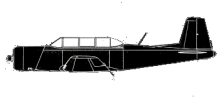
ASN Wikibase Occurrence # 225691
This information is added by users of ASN. Neither ASN nor the Flight Safety Foundation are responsible for the completeness or correctness of this information.
If you feel this information is incomplete or incorrect, you can submit corrected information.
| Date: | Friday 21 October 2016 |
| Time: | 14:30 |
| Type: |  Nanchang CJ-6 |
| Owner/operator: | Private |
| Registration: | N33CY |
| MSN: | 4332005 |
| Fatalities: | Fatalities: 0 / Occupants: 1 |
| Other fatalities: | 1 |
| Aircraft damage: | Minor |
| Category: | Accident |
| Location: | Blackshear, GA -
 United States of America United States of America
|
| Phase: | Manoeuvring (airshow, firefighting, ag.ops.) |
| Nature: | Private |
| Departure airport: | Waycross, GA (KAYS) |
| Waycross, GA (KAYS) | |
| Investigating agency: | NTSB |
| Confidence Rating: |
The accident occurred during the third formation of a four-airplane formation flight when two of the airplanes, call sign Bama 3 (Nanchang CJ-6A, N10EB) and call sign Bama 1 (Nanchang CJ-6A, N33CY), collided midair. After performing three successful formations involving pitchouts and rejoin maneuvers at an altitude of 2,500 ft msl, the pilots began a fourth rejoin maneuver. The lead airplane, Bama 1 was established in a right turning rejoin. The second airplane in the formation, Bama 2, joined the lead airplane on the inside of the turn, about 45° aft of Bama 1's right wing. The third airplane in the formation, Bama 3, was expected to approach from the inside of the turn and cross behind and under the formation to join the outside of the turn off of Bama 1's left wing. However, during the approach, the pilot of Bama 3 was forward of (actue), instead of behind, Bama 1's position. In addition, the Bama 3 airplane had a high closure rate, and the Bama 3 pilot did not announce that he was "overshooting" in accordance with the formation flying group's published guidelines; An overshoot is necessary to dissipate the energy of an approaching airplane with a high rate of closure by flying wide to the outside of the formation.
The pilot of Bama 1 saw that the Bama 3 pilot was approaching at an acute angle and high closure rate and instructed him over the radio to "take it to the outside" to overshoot. As Bama 3 approached Bama 1 from the right, the Bama 1 pilot saw Bama 3 pass under his airplane from the right and expected to see the airplane emerge off of Bama 1's left side. However, the pilot of Bama 2 reported that, as Bama 3 passed under Bama 1, Bama 3 climbed steeply and collided with Bama 1. The propeller of Bama 1 struck the tail of Bama 3 as it climbed, severing the tail from the airplane. Bama 3 then pitched down, entered uncontrolled flight, and impacted terrain.
Initially, the pilot of Bama 3 mismanaged the rejoin maneuver by closing with the lead at to high of a rate, remaining forward of the lead airplane, and not recognizing that his airplane was directly approaching the lead airplane. He then failed to properly conduct an overshoot maneuver that would take him below and behind the lead airplane and instead, passed directly underneath the lead airplane from the right and initiated a climb before his airplane was clear of the lead, which resulted in the collision.
The autopsy results for the Bama 3 pilot found evidence of mild coronary artery disease, which did not affect the pilot's performance during the accident flight. Toxicological testing indicated that the Bama 3 pilot had used marijuana, but the amount of tetrahydrocannabinol (THC, the active component in marijuana) was too low to be quantified. While the amount of THC's inactive metabolite could be quantified, there was not sufficient evidence to determine whether the pilot's marijuana use contributed to the accident.
Probable Cause: The Bama 3 pilot's failure to properly conduct an overshoot maneuver and his premature climb before he was clear of the lead airplane, Bama 1, which lead to a midair collision.
Accident investigation:
 |
|
Sources:
NTSB
Location
Revision history:
| Date/time | Contributor | Updates |
|---|---|---|
| 01-Jun-2019 07:29 | ASN Update Bot | Added |
| 01-Jun-2019 19:20 | harro | Updated [Aircraft type, Total fatalities, Other fatalities, Phase, Departure airport, Destination airport, Narrative] |
Corrections or additions? ... Edit this accident description
The Aviation Safety Network is an exclusive service provided by:


 ©2024 Flight Safety Foundation
©2024 Flight Safety Foundation